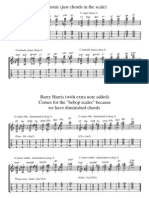Sit down with the legendary Barry Harris for a piano and theory lesson that will expand your harmonic vocabulary and give you deeper insight into the music!L. Barry Harris Keeps Things Movin’, by Howard Rees Keyboard Magazine Article – October 1998 At the heart of Barry Harris’s Theory of Evolution is the chromatic scale, shown on the top staff with enharmonic equivalents (i.e., different note names representing the same pitch, such as D sharp and E flat).Separate the solid and hollow noteheads. Research Process: I transcribed two DVD boxes containing 8 discs of over 8 hours of workshops by pianist Barry Harris that were recorded and published by Howard Rees. Furthermore, I transcribed about 54 video's of Barry Harris that were published on the website, www.franselsen.com, and several solo's of him. Jazz Cultural Theater. Larry Ridley, Barry Harris, Jim Harrison, and Frank Fuentes were partners in creating the Jazz Cultural Theater beginning 1982. Located at 368 Eighth Avenue in New York City in a storefront between 28th and 29th Streets in Manhattan, it was primarily a performance venue featuring prominent jazz artists and also hosted jam sessions. 1 Full PDF related to this paper. Barry Harris Jazz Workshop - Howard Rees. Barry Harris Jazz Workshop - Howard Rees. Juan Pablo Bolo.
Here's a great excerpt from a Barry Harris workshop where he introduces an interesting diminished concept, which he (jokingly) calls his 'personal scale'. It produces a very cool jazz sound by a quite unexpected means. The video is a bit piano-focussed so I thought it might help some guitar players to have a summary from our point of view of the main idea.
Here's the video:
The scale is in fact just a major scale with an added b6 or #5, so it's spelled like this:
1 2 3 4 5 b6 6 7
C D E F G G# A B


More exotically, you could think of this as Harmonic Major with an added natural 6. You may think this is perverse, since the other way is clearly simpler, but in fact that b6 contributes a very strong Harmonic Major sound. You can find full guitar fingerings for this scale on page 298 of the current version of Scale and Arpeggio Resources -- if it's not there, search for the interval map 't, t, s, t, s, s, t, s' and you'll find it.
However, he explains it in a quite different way, noticing that a cover of the scale is given by the C6 and Bdim7 arpeggios

C E G A + B D F G#
This is what I call a 'disjoint cover' because the two parts share no common notes. Adding a note to the major scale is quite easy, of course, but it will tend to lead you to play in a scalar, stepwise way; this way of thinking encourages you to see the underlying chord as the C6 arpeggio and the tension notes as the Bdim7, which is easy to find in relation to it.
You can, of course, use this on any Maj7 type of harmony as well as on chords explicitly written with a 6. So one way to think of this is 'On a Maj7 type of chord, play the diminished arpeggio built on the 2, 4, #5 or 7.
Barry Harris Workshop

Being a pianist, though, Barry shows us a bit more when he moves to thinking of it in terms of chords. To start with, he points out that it contains the dominant 7 chord of the relative minor as well as the major keys, which makes for strong chord substitutions like E7-Am7 subbing for C6, and enables us to construct chord-scales like these (notice the different chord qualities that become available):
Barry Harris Jazz Theory
C6 Dm7b5 Em7 FMaj7 G7 Abdim7 Am7 Bdim7 C6
C6 Dm7 Em7 FmMaj7 G7b9 Ab+ AmMaj7 Bm6 C6
He also very quickly moves on to another, related scale obtained by flattening the third of the scale:
1 2 b3 4 5 b6 6 7
C D Eb F G G# A B
This time we can think of this as a Melodic Minor with an added #5 or b6, or as a Harmonic Minor with an added natural 6. Again we have an alternative perspective provided by a disjoint cover: the m6 arpeggio plus the same dim7 we used before. So this rule suggests that we can use this dim7 superimposition idea over minor chords as well as major! You can find full guitar fingerings for this scale on page 298 of the current version of Scale and Arpeggio Resources -- if it's not there, search for the interval map 't, s, t, t, s, s, t, s' and you'll find it.
There's a bit more in the video about using chords borrowed from these scales, but the specific voicings are quite pianistic -- listen, play along and see if you can devise your own chord sub ideas using these scales, as well as using them for melodic interest in your solos.
Barry Harris Jazz Piano
[UPDATE: After posting this I was tipped off to Alan Kingstone's great book applying many of Harris's ideas to guitar. It's really good.]